Planning a trip to Athens and wondering which Acropolis attractions are truly worth your time? This iconic hilltop is packed with temples, theaters, gates, and viewpoints, each with a story stretching back thousands of years. From the mighty Parthenon to the hidden corners most travelers miss, here’s your guide to the can’t-miss sights at the Acropolis.
Top Acropolis Attractions in Athens
From legendary temples to hidden ruins, these Acropolis attractions showcase thousands of years of history in the heart of Athens.
11. Beule Gate
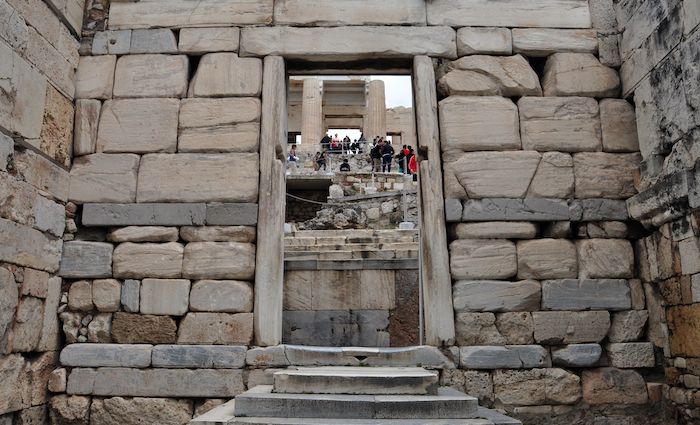
Past the ticket booth and a short walk up the pathway, you’ll see the Beule Gate. The gate is a Roman addition to the Acropolis from the mid-third century A.D. This arch gets its name from the French archaeologist behind the mid-19th-century excavation, Ernest Beule.
For visitors in Roman times, this would have been your gateway to the main Acropolis attractions.
10. Porch of the Maidens
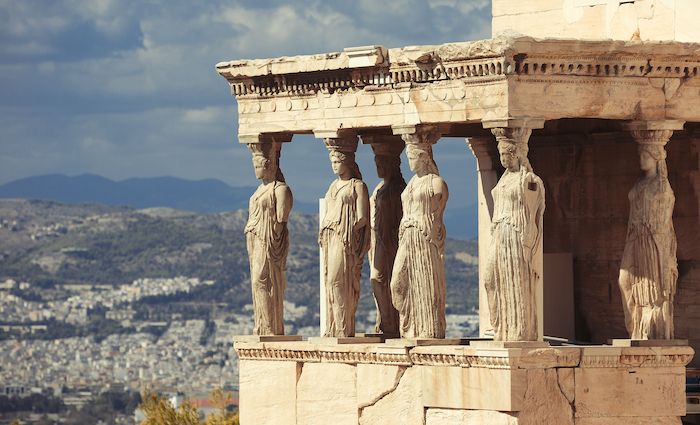
The southern side of the Erechtheion is held up by six striking caryatid statues, arranged in a horseshoe and facing the Parthenon. Historian Michael Llewyn-Smith calls this the Porch of the Maidens, Poseidon’s consolation prize after losing Athens to Athena. She had the advantage, historian Paul Cartledge notes, with her name, her olive tree gift, and her warlike spirit.
The famous figures here are only replicas, preserved to protect the originals. Five authentic maidens now reside in the Acropolis Museum. Their lone sister can be found in the British Museum in London.
9. Theater of Dionysus
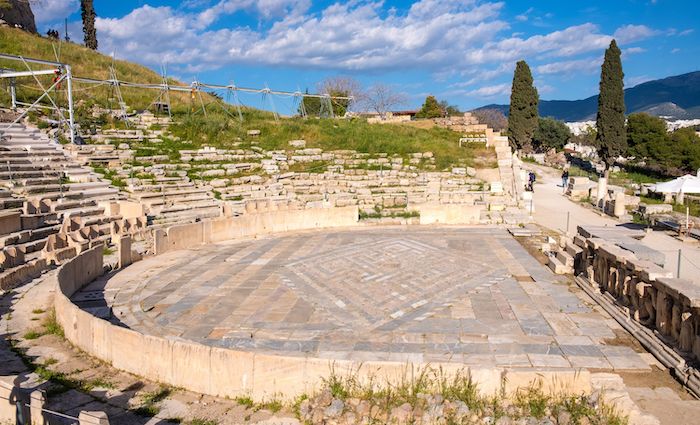
Perched on the southern slope of the Acropolis, the Theater of Dionysus was the place to be in 330 B.C. Named for the god of wine and fun, it drew Athenians for tragedies that examined life and comedies that roasted local celebrities. Nearly 20,000 people could fill its marble seats, making it the city’s largest public gathering spot.
Beyond entertainment, the theater symbolized Athenian democracy, even serving as a meeting place for the government. Standing here today, it’s easy to picture the roar of the crowds that once filled the air.
Check Out Our Best Acropolis Tours
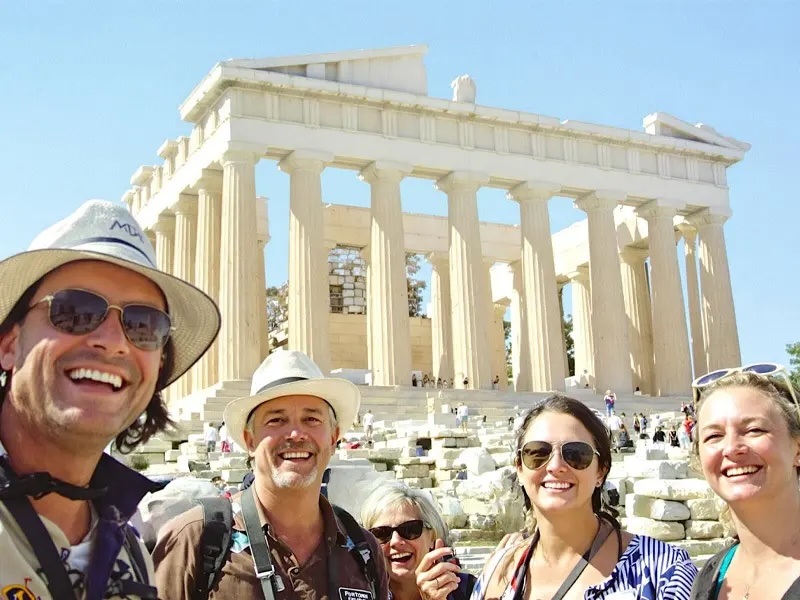
Complete Skip-the-Line Acropolis & Parthenon Tour with Guided Museum Visit
4 Hours | €€€
Discover the ancient mythology and historic landmarks of Athens with an expert archaeologist guide.
Book Now!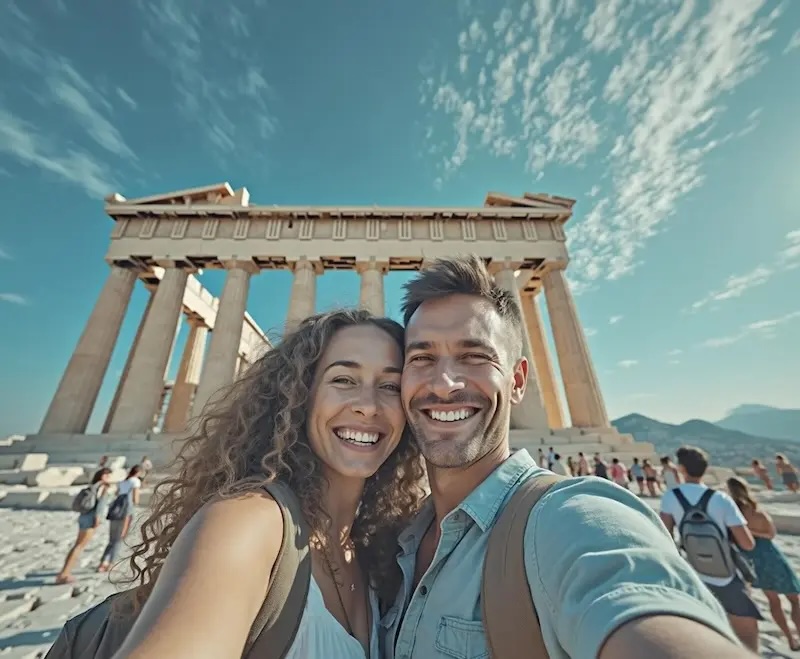
Essential Highlights Tour of the Acropolis and Parthenon
2 Hours | €€
Skip the line and get to know Greece’s most important ruins, including the Temple of Athena Nike.
Book Now!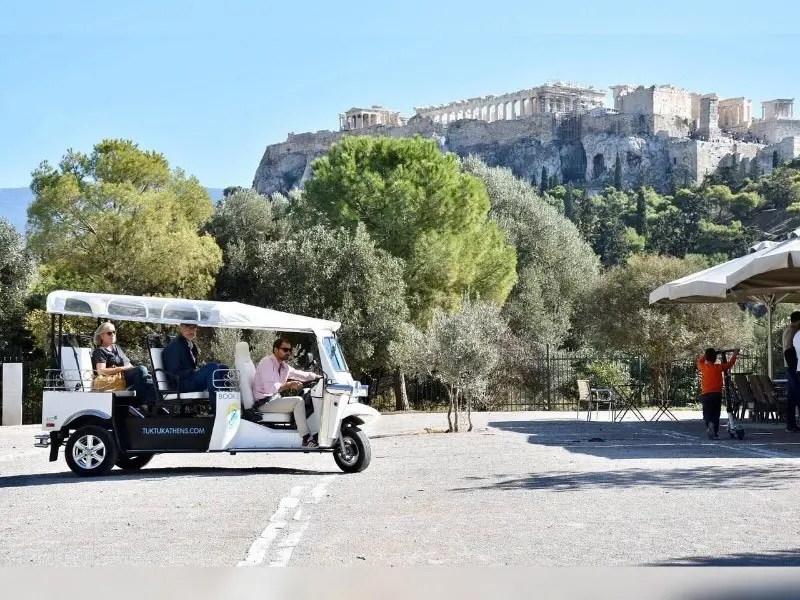
Athens Private Sightseeing Tour by Golf Cart
3 Hours | €€
Glide around the ancient city in order to see all the top spots of Athens!
Book Now!8. Flagpole on the Belvedere
This is a great spot to enjoy late afternoon shade between the Acropolis attractions. Besides that, the flagpole on the Belvedere offers views fit for Greek gods over much of Athens. As such, many ancient and modern landmarks come into focus when standing on the raised platform.
And yes, even the flagpole at the Acropolis has a lot of history. For instance, during the German occupation of Athens in WWII, Manolis Glezos (1922 – 2020) and a friend stuck it to the Nazis by hauling down the flag of Nazi Germany from the Acropolis. Subsequently, Glezos became a national hero and mainstay figure in Greek political life.
7. Stoa of Eumenes
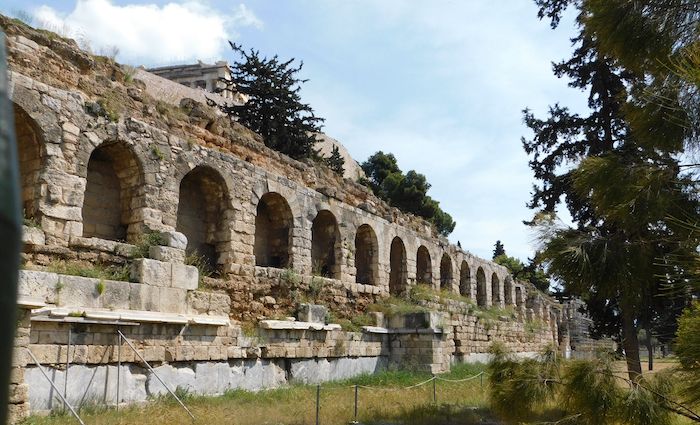
The Stoa of Eumenes is yet another sign of the importance of theater in the daily life of ancient Athenians. It served as a promenade and shelter from bad weather for theatergoers. If you’re visiting the Acropolis in the summer months, you’ll enjoy the shade of the remaining arches as much as the ancient Athenians. In fact, you might even ask who you need to tag in a thank-you post for building this shady spot.
That would be Eumenes II, King of Pergamon. According to Roman author Cornelius Nepos, Eumenes built the stoa during the Hellenistic period in the 160s B.C. So, you could say the stoa is an ancient example of personal branding. For instance, Eumenes hoped that in return for the shade, the Athenians would give him favorable business deals. Did it work out for Eumenes? Well, it’s not called the Stoa of John Stamos.
6. Ceremonial Sundays
For those desiring pomp and circumstance on their Acropolis visit, join the Sunday flag processions led by the elite soldiers called Evzones (Presidential Guard). In addition, Sunday flag ceremonies come complete with a band playing the Greek national anthem. Greek soldiers perform the flag duties on other days, without the fancy uniforms and accompanying music.
Top Hotels in Athens

Divani Palace Acropolis ⭐⭐⭐⭐⭐
Acropolis View • Rooftop Terrace
Spacious classic‑decor rooms (many with balcony views), seasonal pool, sauna, fitness center, and on‑site gourmet restaurant.

Royal Olympic Hotel ⭐⭐⭐⭐⭐
Decadent Rooms • Temple Views • Pool
Elegant rooms, library lounge, poolside terrace and seasonal outdoor pool—all overlooking Temple of Zeus and National Garden.

NJV Athens Plaza ⭐⭐⭐⭐⭐
Modern Decor • Family‑Friendly
Stylish rooms overlooking Syntagma Square, Mediterranean dining, modern décor, plus easy access to Kolonaki shopping.
5. Odeon of Herodes Atticus
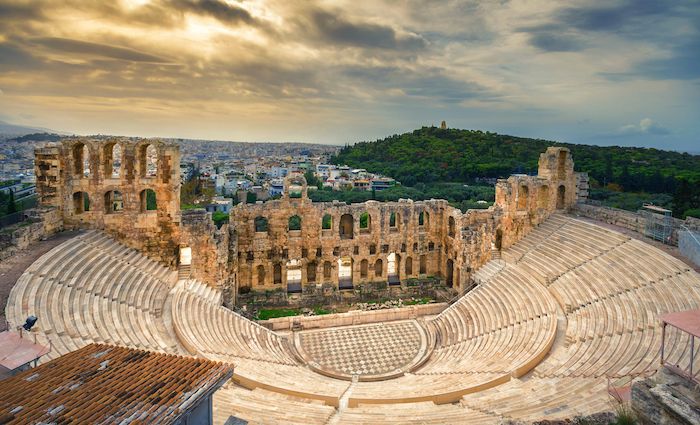
Herodes Atticus was a rich Roman official during the reign of Emperor Hadrian. Rather than spend his fortune on wine and song, as scholar Robin Wakefield tells us, Herodes used it for the public good. For example, Herodes funded an odeon in A.D. 161 on the southern slope of the Acropolis.
The venue impressed ancient writers. Philostratus tells us that the odeon had a roof made of cedar wood. Cedar was expensive to use even for small statues, let alone a whole building.
At this time, the Odeon of Herodes Atticus is only open during performances. Between June and October, you can take in a concert or play from seats where ancient Athenians witnessed performances of legendary Greek plays and where more recent crowds rocked out to Elton John and the Scorpions.
4. Temple of Athena Nike
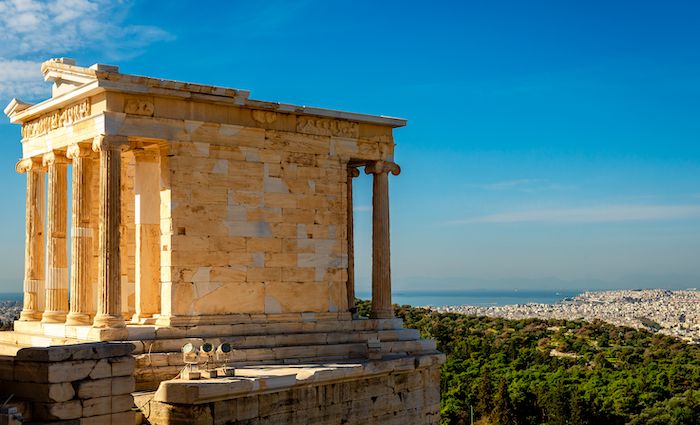
South of the entranceway to the top of the Acropolis is the tidy and compact Temple of Athena Nike. Designed by the famous architect Kallikrates and built between 421-415 B.C., the temple is now in its third iteration. According to archaeologist Ioanna Venieri, the temple endured a fair share of destruction at the hands of conquerors like other buildings on the Acropolis.
First demolished by the Ottomans between 1686 -1687 to mount cannons, the current construction only dates from 2003. Fortunately, dozens of marble reliefs from the original structure survive in exhibition spaces at the Acropolis Museum and British Museum.
3. Propylaea
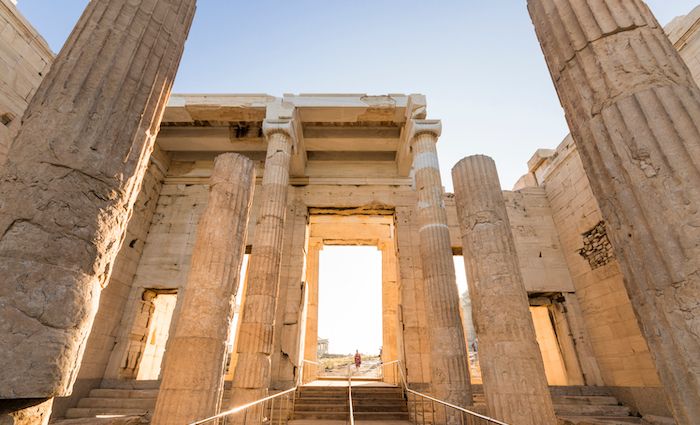
Talk about making a grand entrance. The Propylaea is an impressive columned staircase leading to the top of the Acropolis. For ancient writers Pausanias and Demosthenes, it was as impressive as the Parthenon.
Athenian officials even intended to extend the Propylaea outward with big marble wings. However, a war against Gerard Butler—I mean—Leonidas’ Spartans in 431 B.C. ensured this plan never materialized.
Resist the temptation to rush up the final steps to reach the summit of the Acropolis and admire the panoramic view of Athens, Phaleron Bay, and the port city of Piraeus.
Discover More of Athens By Joining a Guided Tour

Athens Local Food Tour in Monastiraki
4 Hours | €€
Discover the real taste of Greece with a fun foodie guide and explore amazing Varvakios Agora Market.
Book Now!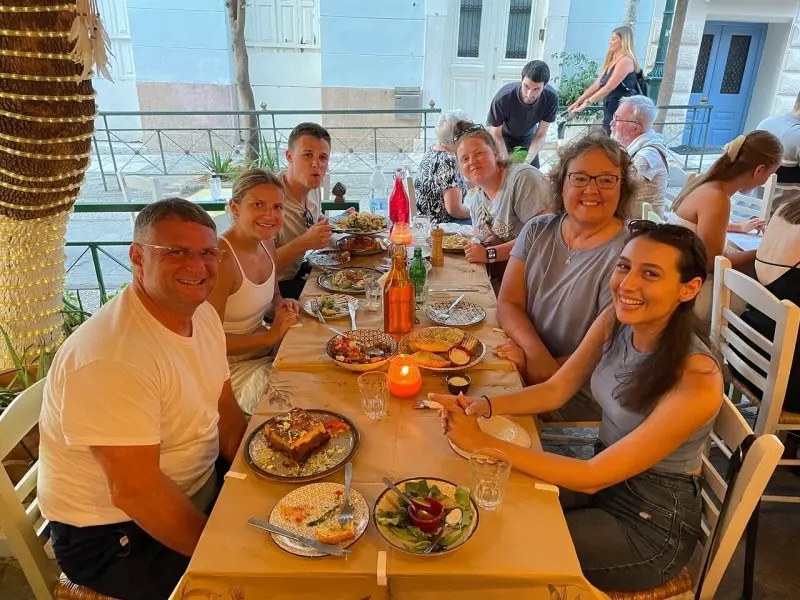
Athens by Night Walking Tour with Dinner
5 Hours | €€
Admire the Parthenon, wander through the oldest neighborhood in Athens, and dine at a Greek taverna.
Book Now!
Greek Islands Boat Tour by Wooden Ship from Athens
10 Hours | €€€
Cruise clear blue seas to the gorgeous Saronic Islands, with snorkeling, meals, and drinks included.
Book Now!2. Erechtheion
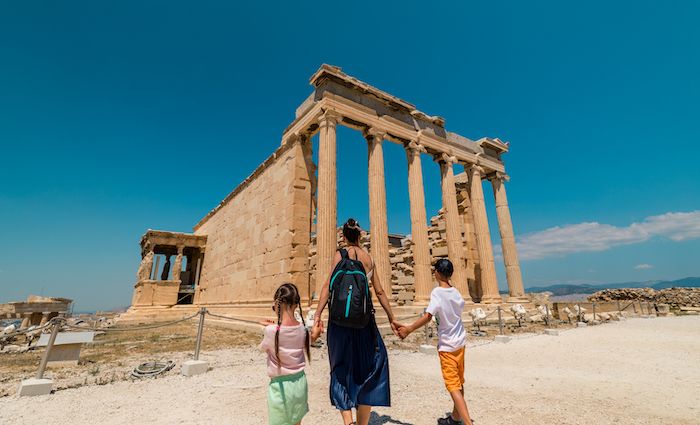
The Parthenon is certainly the most recognizable Acropolis attraction. But the most sacred to ancient Athenians was the Erechtheion. As archaeologist Efi Gianikapani tells us, the Erechtheion was constructed on the north side of the Acropolis between 421 and 405 B.C.
The Athenians dedicated the temple to three deities. Above all, Athena received pride of place. Secondly, Athenians celebrated a mythical king named Erechtheus. Paul Cartledge tells us this king is often confused with a shady character named Erechthonius.
Finally, the Athenians cleverly hedged their bets by honoring Poseidon at the rear of the temple. Like the other temples on the Acropolis, the Erechtheion has performed multiple functions. For example, it served as a Christian church and after that as a harem for the city’s Ottoman commander.
1. Parthenon
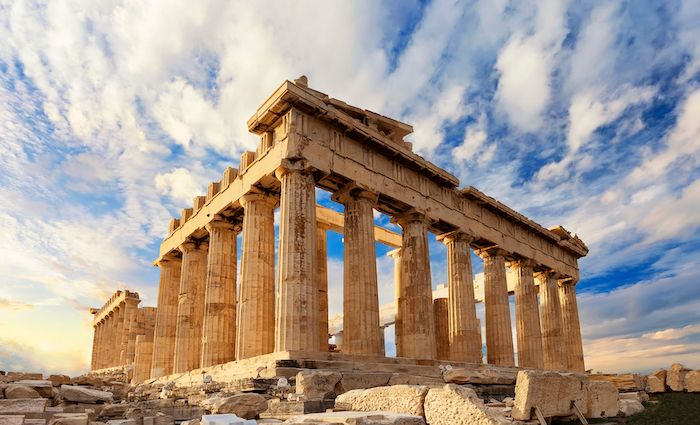
Built quickly under Pericles between 448 and 432 B.C., the Parthenon was the grandest temple ever to rise on this sacred hill, boasting massive marble friezes and a towering statue of Athena. Don’t let the scaffolding scare you off—the white marble gleams in the midday sun and glows honey-gold by late afternoon, while every scar tells a piece of its long history. The Parthenon has survived cannon fire, including a devastating Venetian strike in 1687, and centuries of looting. Many of its treasures now reside in the nearby Acropolis Museum, safe from further loss.
Though the Erechtheion held the highest sanctity in antiquity, the Parthenon became a major pilgrimage site in the Eastern Roman, or Byzantine, Empire. Over the centuries, it transformed from a Christian church to a Roman Catholic cathedral and later an Ottoman mosque. As scholar Bente Kiilerich notes, few sites outside the Holy Land can match such a rich, multi-faith legacy. Today, the Parthenon is still the Acropolis’ crown jewel—so snap that selfie, you’ve earned it.
Not ready to book a tour? Check out our Athens Guide for more resources.
Bonus: A Brief History of the Acropolis
The Acropolis has watched over Athens for thousands of years, serving as a spiritual, political, and artistic symbol of Ancient Greece. First inhabited around 5,000 B.C., this rocky hill still dominates the city skyline, visible from nearly every winding street below.
Part citadel, part sanctuary, the Acropolis has always been coveted. Mythology tells of gods and mortals battling for control, with Athena famously defeating Poseidon to become the city’s patron. Later, Romans and Ottoman Turks would take their turn as conquerors.
By the 8th century B.C., Athenians had dedicated the hill to Athena, and under the leadership of Pericles during the city’s Golden Age (450–400 B.C.), the Acropolis became a showcase of power and pride. The once-simple temples—some damaged by the Persians in 479 B.C.—were rebuilt into the breathtaking classical complex you see today.
Final Thoughts
Exploring the Acropolis is like walking through the pages of ancient history. Every temple, theater, and column tells a story of gods, battles, and artistic brilliance. Take your time here—you’re standing on the same stones that shaped Western civilization.
More resources for your Athens adventure:
Top Things to Do in Athens in 2025
Best Acropolis Tours to Take and Why
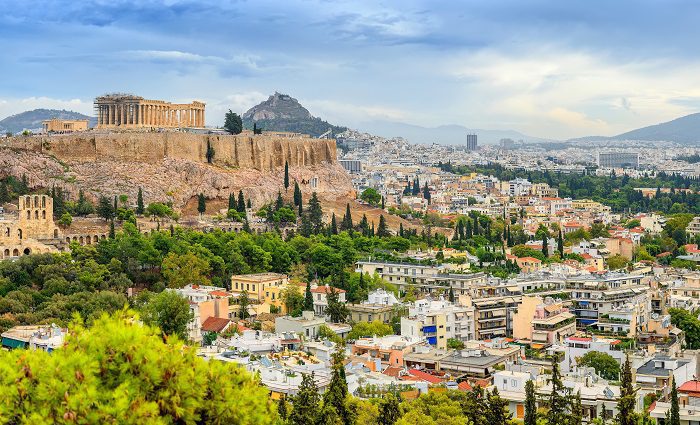
Where To Stay in Athens
A great hotel at a great price has become the norm in this internet era. Our article explains what areas are the best in Athens, so you can get a great deal in the perfect location!
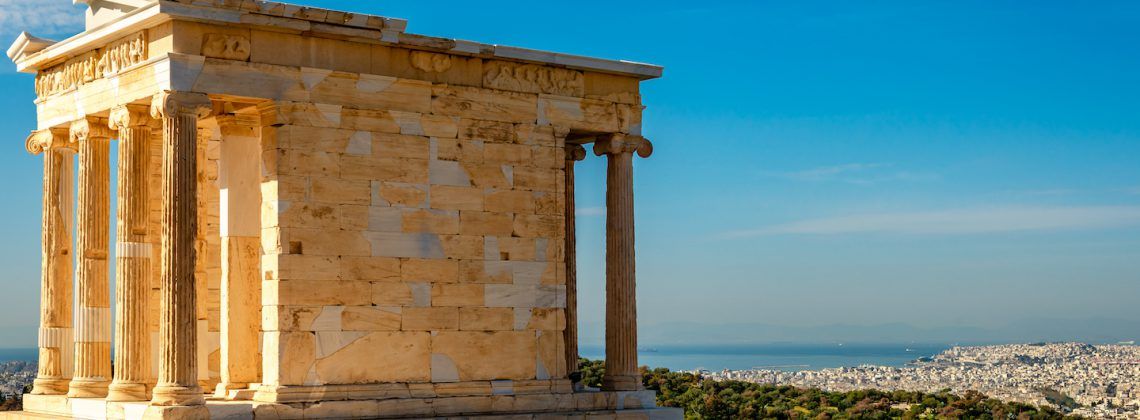
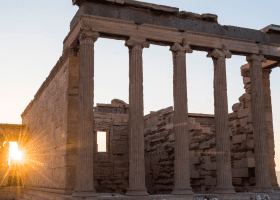
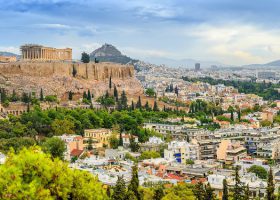
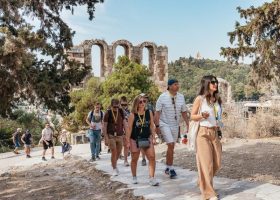
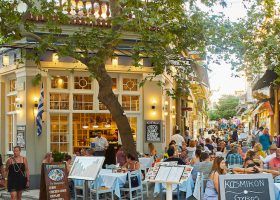

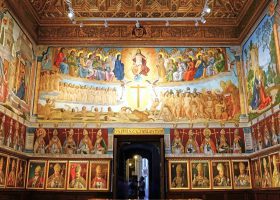


Thank you very much. This tutorial was fun, an easy read and very informative. When we come in September, we will most likely hire the tours spotlighted in your article.